“Armistead at Gettysburg” by Keith Rocco
The bonds of friendship forged by soldiers are some of deepest and long lasting that are formed anywhere. For American military professionals those bonds are formed in the small rather closed society that is the regular United States military. They are formed in war and peace, and are marked by years of deployments, isolated duty and combat. They are part of a culture that is often quite different than that of civilian society. That is the case now as it was in 1860.
When the Southern States seceded from the Union men who had spent much of their adult lives serving together discovered had to say goodbye and prepare to fight each other. Most did so with a heavy heart even though many had strong convictions about the rightness of their region’s cause. Those who left the army to serve the Confederate states were often torn by doubt and questions of where their loyalty lay. They wrestled with their oath of office and the costs of perhaps having to face their dearest friends on future battlefields.
They were different from the mass levies of civilian volunteers who rallied to the flags of the Union and Confederacy in 1861. The volunteers, most of whom did not have the deep and abiding friendships of the professionals were often motivated by ideological, sectional or religious hatred of the other and went to war with great aplomb.
The American Civil War has many such tales. One of the most remembered is that of Union General Winfield Scott Hancock and Confederate General Lewis Armistead. It was key story line in Michael Shaara’s Pulitzer Prize winning novel The Killer Angels was immortalized in the movie Gettysburg which is based on Shaara’s novel.
 Major General Winfield Scott Hancock USA
Major General Winfield Scott Hancock USA
Hancock was from Pennsylvania. He was a career soldier and Infantry officer, a graduate of West Point Class of 1844. He served in Mexico and held numerous positions. In 1861 he was stationed in California as a Quartermaster under the command of Colonel (Brevet Brigadier General) Albert Sidney Johnston. One of his fellow officers was Captain Lewis Armistead, a twice widowed Virginian who also served as a commander of the New San Diego Garrison under Johnston’s command. Hancock and his wife Almira became fast friends with the widowed Virginian.
Armistead was a nephew of the officer who defended Fort McHenry from the British in the War of 1812. Armistead had academic and personal difficulties at West Point including an altercation with Jubal Early in which he broke a plate over Early’s head. Between his academic difficulties and the fight with Early he resigned from the Academy. However, his father helped him obtain a commission as an Infantry officer in 1839. Armistead’s career from that point on was similar to many other officers of his day. He served with distinction in Mexico, the Great Plains, Kansas, Utah and California.
As the war clouds built and various southern states seceded from the Union numerous officers from the South were torn between their oath, their friendships and their deep loyalty to their home states and families. In the end most Southern officers resigned their commissions, many with mixed feelings and quite often sadness. A minority of southern born officers remained loyal to the Union. The most prominent of these men were General Winfield Scott and Major General George Thomas, the “Rock of Chickamauga.” Likewise Union Brigadier General John Buford’s family in Kentucky supported the Confederacy.
For those southern officers who remained loyal to the Union to was often at a great personal cost. Thomas’s action cost him his relationship with his immediate family who deemed him to be a traitor. He and others were pilloried and demonized in the basest ways by many in the South. Some Southerners who served the Union were executed when they were captured. George Pickett, who called for his fellow Virginian Thomas’ death ordered 22 North Carolinians who he captured fighting for the Union in Kinston North Carolina to be executed and he was not alone.
Brigadier General Lewis Armistead CSA
However, for most it was different. As talk of secession and war heated up officers stationed on the frontier debated the issues and asked each other what they would do if war came. In California Armistead and other officers asked Hancock, who was a Democrat and not openly hostile to the South, advice on what he would do if war came. Hancock’s reply was simple. “I shall not fight upon the principle of state-rights, but for the Union, whole and undivided”
The parting came in 1861. When it was apparent that many officers would be resigning and heading home to join their state’s forces the Hancock’s hosted a going away party for their friends. Almira Hancock wrote of the party that “Hearts were filled with sadness over the surrendering of life-long ties.” Colonel Albert Sidney Johnston’s wife Eliza went to a piano and sang the popular Irish song Kathleen Mavourneen:
“Mavourneen, mavourneen, my sad tears are falling, To think that from Erin and thee I must part!
It may be for years, and it may be forever, Then why art thou silent, thou voice of my heart?…”
The parting was especially emotional for Armistead who had been a friend of the Hancock’s for 17 years. They had helped in following the death of both of his wives and children. He was tearful. He put his arm on his friend’s shoulder as he said: “Hancock, good-by; you can never know what this has cost me, and I hope God will strike me dead if I am ever induced to leave my native soil, should worse come to worse.”
Armistead led his brigade during the Peninsula campaign and battles around Richmond and his brigade was decimated in Lee’s failed assault on prepared Federal positions at Malvern Hill. Armistead did not endear himself to many of the volunteer officers who served in the Confederate ranks. One of his Colonels resigned over Armistead’s supposedly harsh treatment to which Armistead replied: “I have felt obliged to speak to him as one military man would to another and as I have passed nearly all my life in camps my manner may not be understood or appreciated by one who has been all his life a civilian.” Armistead’s words can easily be understood by military professionals whose lives have been shaped in a different manner than their civilian counterparts.
At Gettysburg Armistead spoke his fears to his comrades. One was Brigadier General Dick Garnett, another of Armistead and Hancock’s comrades from the California days on the night of July 2nd. The next afternoon Armistead and Garnett led their brigades of Pickett’s Division against Hancock’s II Corps which was defending Cemetery Ridge.
During the engagement Garnett was killed just before reaching the Union lines and Hancock gravely wounded. Armistead, lead the remnants of his decimated brigade to the Stone Wall, near the Copse of Trees. He rallied his troops fearing that some were faltering calling out: “Come on boys, give them the cold steel! Who will follow me?”
His troops breached the Union line and his black hat atop his sword led his troops forward. It was then that he met more Federal troops who unleashed a volley of musket fire that cut down many of the survivors. Armistead was wounded in the right arm and shoulder and fell near one of the Union artillery pieces, a point now known as “The High Water Mark” of the Confederacy.
As Armistead lay wounded he was approached by Major Bingham of Hancock’s staff. Bingham, a Mason noticed that Armistead was making a Masonic sign of distress. When Bingham told Armistead of Hancock’s injury Armistead was grieved and told Bingham to “Tell General Hancock for me that I have done him and you all an injury which I shall regret the longest day I live.” The meaning of those words is debated, especially by Southerners who cherish the myth of the Lost Cause. However, based on Armistead’s conduct and behavior in the time before he left California, it is not unreasonable to assume that as he lay dying he truly regretted what he had done. He gave Bingham a wrapped Bible and Prayer book to give to Almira Hancock, inscribed were the words “Trust in God and fear nothing.”
“Minnesota Forward” Hancock directing the Defense by Dale Gallon
Armistead died from infections caused by his wounds which were initially not thought to be life threatening. A Union surgeon described him as: “seriously wounded, completely exhausted, and seemingly broken-spirited.”
Hancock’s injuries were severe, but he recovered. He would go on to continued fame and be one of the most admired and respected leaders of the Army during and after the war. He was gracious as a victor and spoke out against reprisals committed against Southerners after the war.
In 1880 Hancock was the Democratic nominee for President. He lost a close election to James Garfield, losing the popular vote by fewer than 40,000 votes. It was an era of great political corruption and Hancock was one of the few major public figures viewed favorably for his integrity. Even his political opponents respected him for his integrity and honesty. Former President Rutherford B Hayes said:
“if when we make up our estimate of a public man, conspicuous both as a soldier and in civil life, we are to think first and chiefly of his manhood, his integrity, his purity, his singleness of purpose, and his unselfish devotion to duty, we can truthfully say of Hancock that he was through and through pure gold.”
A few years after his death Republican General Francis A Walker, lamenting the great corruption of the time said:
“Although I did not vote for General Hancock, I am strongly disposed to believe that one of the best things the nation has lost in recent years has been the example and the influence of that chivalric, stately, and splendid gentleman in the White House. Perhaps much which both parties now recognize as having been unfortunate and mischievous during the past thirteen years would have been avoided had General Hancock been elected.”
The story of Hancock and Armistead is one that reminds us of the depth of friendships that many military professionals develop and cherish. It is also a story that reminds us of how hardened ideologues can divide a nation to the point of civil war. It is a story that should give pause to any political or spiritual leader that incites people to war against their neighbor and uses their ideology to slander, demean or even enslave and brutalize their political opponents.
The blood of the approximately 50,000 soldiers that were killed or wounded during the three days of the Battle of Gettysburg is ample reminder of the tragedy of war, especially war that forces the dearest of friends to fight and even kill one another.
Peace
Padre Steve+

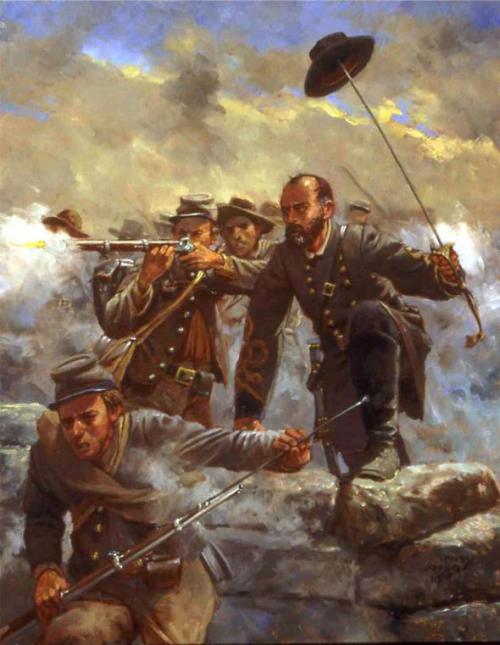
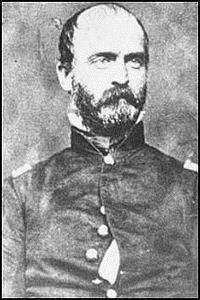
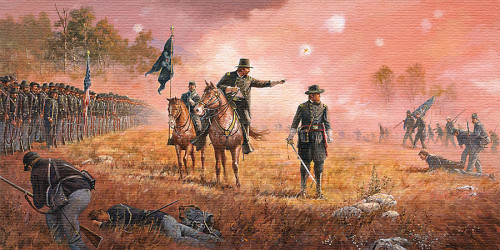
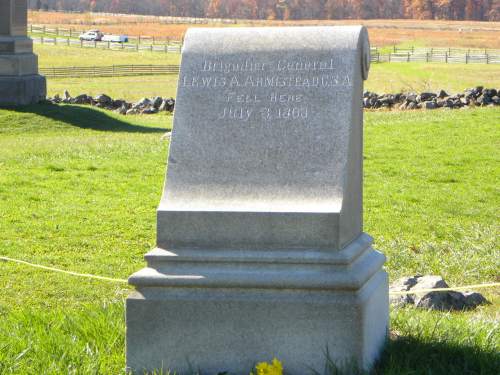
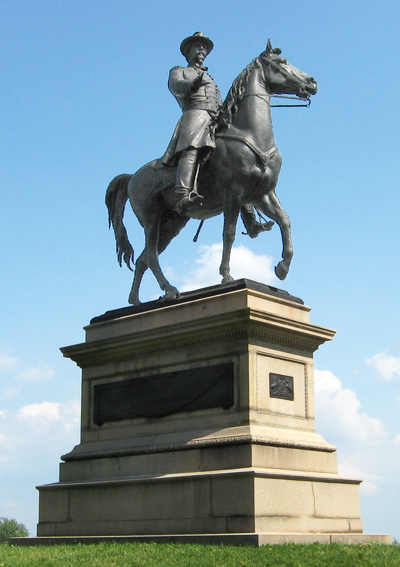

Pingback: An Independence Day Story – Events Leading Up to The Gettysburg Address – Brian's Blog
La guerre est la pire chose qui se doit d’arrivée dans ce monde. L’homme se crois supérieur à Dieu et lui tiens tête grave erreur
Oui, tellement vrai. Un commentaire triste sur notre monde. Merci pour le commentaire.
Thankyou for posting this detailed accounting of this special friendship. Its something history books and quick TV shows can’t portray. Thanks again,
God Bless
A great Nugget of Civil War History, so many stories , not just the battles.
Thank you, people are the one constant in history, and more often than not the most important part
Very good piece. In Shaara’s book, the Confederate generals spoke in muted tones about swearing a sacred oath to the United States and the conflict each fought in their hearts the night before Picket’s charge. In Gods and Generals, we see the irony of the Irish 116th Pennsylvania facing the Irish Georgia Brigade… the Buster Kilrain Irish character remarks to Colonel Chamberlain on how they both know people on the other side, “Some of the lads that I left Ireland with are on the other side as well. Imagine that. We left together to escape a tyranny…and end up shootin’ at one another in the Land of the Free.”
I like Shaara’s treatment of the men who fought the battle.
Love the writing. I just wonder if these riots are going to tear down this statue too. Pathetic people who tear down history are doomed to repeat it, in the most horrible fashion.
I sincerely doubt that, it is in a Federal Military Cemetery, and is inaccessible at night. The same goes for once on the battlefields. They were not placed to remind blacks of how inferior they were as were most of the Confederate statues that went up by the hundreds after Plessy v. Ferguson, the surges of the KKK growth of the 1910-1920s, and during the Civil Rights movement, that proclaimed white supremacy, and the twin myths of the Nobel South and Lost Cause. This monument in particular was placed by the Masons promoting reconciliation and recognizing the bond between soldiers.
Are the motivations of the “rioters” so foreign to you that it makes sense to that they’d tear down the statue of a Union officer notable to history for his honor and integrity? What would lead you to come to this conclusion?
That’s an honest question. If you have the time, I think I’m open to an honest answer, but only if you could do me a favor – I would like my answer informed only with the facts as you’ve seen with your own two eyes and heard with your own two ears.
First I have to ask you has a statue of General Hancock been torn down? And if so where? I have not seen anything about it it? Since the major BLM protests were almost 8 months ago I am having trouble remembering if any statues of Union Generals or heroes being torn down but many confederate statues came down, some due to the protestors and others because state and local governments decided that they represented something they did not want to continue to commemorate. No statues, Union or Confederate have been vandalized or removed from any State or National Battleground Park. So I am wondering why you are asking this question, and then putting the limitations on me of what I have seen with my eyes or heard with my ears. So please explain yourself or provide some detail so I can actually attempt to answer your question. I did see the vandal action and destruction of the Confederate Monument in Portsmouth Virginia as I worked less than a mile from it. I had lobbied the Portsmouth City Council to remove it to a less public location (it sat in the old Courthouse Square where the slave auctions were held and a block from the slave jail). It was one of the most unique and artistic statues to the Confederate dead and had the City Counsel taken action to move it before George Floyd was killed, or immediately agreed to have it moved instead of playing bureaucratic games it would have not been destroyed. The ruin has been removed and supposedly it will be restored and placed in a more appropriate place such as in a cemetery where many of the city’s civil war dead are buried, which I support as the initial money raised for the statue came from the donations of the city’s war widows.
But please explain yourself as your question lacks context for me to answer it.
Renee or whoever you are pretending to be. I find no record of your name anywhere and your email account seems to belong to someone else. I think that you are a fraud and poser. Come back and I will block you forever. I gave you enough time to explain yourself. You IP address is in Seattle but the email address is from another state with a different name. There is a Kayem Foods in Seattle but no Renee in their records. Give it up.